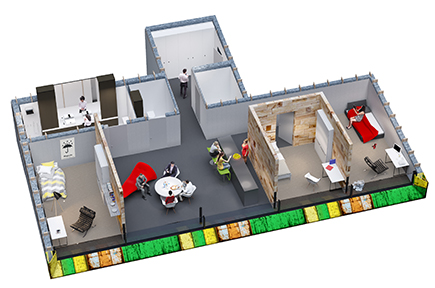5,000+ visitors since opening of NEST
Planning for new NEST units picking up speed
NEST, the modular research and innovation building by Empa and Eawag, is teeming with life. Since it opened its doors in May 2016, over 5,000 visitors have flocked to see the building. The first users have set up their offices, the first residents will soon be moving in and the next units in the pipeline are already taking shape.

For the last few weeks, the NEST unit Meet2Create has been a hive of activity: the first permanent users of the office environment designed by Lucerne School of Engineering and Architecture have moved into their offices; Vision Wood, a residential unit for students and the second unit to be installed, is ready for two residents to move in at the beginning of 2017 and the wood innovations developed by Empa and ETH Zurich to be field-tested; and construction work is about to get underway on the Solar Fitness & Wellness unit: the prefabrication of the system designed to run the entire wellness center on renewable energy is due to begin in early 2017, the official inauguration is scheduled for May 2017.
Growing building materials and waste as a resource

The planning on other units is also in full swing: an east-facing home environment for two people is to be constructed on the second floor, where a consortium comprising Dirk E. Hebel’s ETH Zurich chair, the Institute for Lightweight Structures and Conceptual Design (ILEK) at the University of Stuttgart and the Werner Sobek Group will tackle topics related to urban mining. Construction is scheduled to begin in the second quarter of 2017. Besides a supporting structure where the individual components can be recycled without losing any value when removed, the unit will use waste as a source of materials and utilize prototypical products with a view to exploring the potential of this material resource.
The same goes for so-called “cultivated building materials” – materials composed of fungal components and organic waste that can grow in any choice of forms – which are to be integrated in the unit in a second phase. The entire unit is, therefore, to be constructed in such a way that it can be re-used fully as a materials store after demolition. In order to actually be able to exhaust the urban mine in future, an overview of the material flows and the “stock” is required. The Urban Mining and Recycling unit aims to pave the way for the creation of a corresponding 4D cadastral plan.
Detailed information on the innovation objects in the Urban Mining and Recycling unit is available here.
Robots on the building site and for bespoke prefabrication
The National Center of Competence in Research (NCCR) “Digital Fabrication” based at ETH Zurich is working on another unit. The researchers’ common goal is to combine digital technologies seamlessly with the physical construction process. NEST serves as a real-world test environment for completely novel on-site fabrication and bespoke digital prefabrication technologies. The former involves using the building site robot In situ Fabricator, which will build a steel wire mesh on the building site within the scope of the new construction technology Mesh Mould. At the same time, this mesh will serve as formwork and reinforcement for a supporting concrete wall on the unit’s second floor. In bespoke digital prefabrication, non-standardized, highly integrated wooden construction elements that together will form the unit’s third floor will be produced at the world’s largest architecture and robotics lab at ETH Zurich. Construction on the Digital Fabrication unit on NEST’s top platform is due to commence in the spring of 2017 and be completed in 2018.
Detailed information on the innovation objects in the Digitale Fabrication unit is available here.
Façade as an energy source
The planning of the unit SolAce is making headway at EPF Lausanne. The unit will contain living and office space for two people located on the second floor on the southern face of NEST. Construction is scheduled to begin in the second quarter of 2017. In SolAce, the researchers will focus on the façade and the integration of photovoltaics and photothermals. Besides energy production, however, their research will also center on increasing the comfort inside the unit – achieved via optimum daylight control and other active façade elements.
One-to-one prototype of the HiLo roof in the pipeline
The research and innovation unit HiLo demonstrates the possibilities of lightweight construction. For the two-storey penthouse, which will serve as living and office space for guests, the researchers and architects from ETH Zurich are combining ultra-lightweight construction in the flooring and roof and adaptive building technology based on the example of a solar façade. They are currently concentrating on producing prototypes of the roof construction and the adaptive solar façade. Both cases involve novel developments from ETH Zurich, which enable vast quantities of concrete to be saved. However, the novel plank constructions pose major production challenges, which is why one-to-one prototypes are being made before the construction work actually gets underway. The smooth and safe production of the roof construction is the top priority for the entire project. The experiences and test results will then be channeled into realizing the unit, which is currently scheduled to be up and running in 2018.
ehub with its own research group and initial activities in the Water Hub
A separate research group has formed at Empa to run the Energy Hub (ehub). Following a busy few months with the launch and even the first expansions of the systems, the team is now starting the first research projects. Meanwhile, the majority of the Water Hub has been installed: all the urine that accumulates at NEST and is separated by the separator toilets is already being converted into liquid fertilizer by Eawag researchers. A proportion of the graywater is being filtered through membranes and finally the fecal matter will be processed into pellets from December onwards.
-
Share

